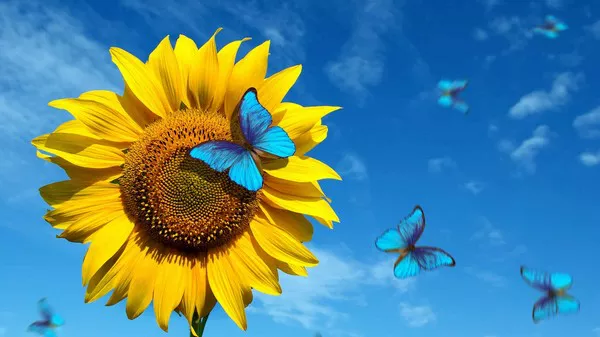Sunflowers, with their radiant blooms and towering stature, bring a burst of sunshine to any garden. However, as with all living things, the lifecycle of a sunflower includes a phase where their vibrant petals fade, and their seeds mature. Knowing what to do when sunflowers die is essential for both garden aesthetics and seed harvesting.
Enjoying the Fading Beauty of Spent Sunflowers
As sunflowers reach the end of their bloom, their once-vivid petals gradually fade and lose their luster. Rather than viewing this as the end of their beauty, consider it a unique stage in the sunflower’s lifecycle. Spent sunflowers, with their muted colors and drooping heads, still exude a certain charm. Allow them to stand in the garden for a while, providing a rustic and natural aesthetic. Their textured seed heads become a focal point, attracting birds and adding a touch of wild beauty to the landscape.
Observing Natural Processes: Seed Maturation
The journey of a sunflower doesn’t conclude when its petals wither; it transforms into a phase where seed development takes center stage. The sunflower’s iconic seed head, often referred to as the “flower” after its bloom, is a treasure trove of seeds. Allow nature to take its course, and observe as the seeds mature within the protective embrace of the flower head. The distinctive spiral pattern of seeds is not only visually intriguing but also an essential aspect of the sunflower’s reproductive cycle.
Harvesting Sunflower Seeds for Future Planting
Once the sunflower has completed its life cycle, harvesting its seeds becomes a rewarding endeavor. To harvest sunflower seeds, wait until the flower head has dried and the seeds have matured. The back of the flower head will turn from green to yellow or brown, indicating readiness. Cut the flower head from the stem, leaving a portion of the stem attached. Hang the sunflower upside down in a dry and well-ventilated area to allow the seeds to continue drying. Once fully dry, gently rub the seeds from the head and store them in a cool, dry place for future planting or as a nutritious snack.
Attracting Wildlife with Sunflower Seed Heads
Spent sunflowers serve as a natural and eco-friendly bird feeder. As the seeds mature, they become a valuable food source for birds, particularly finches, chickadees, and sparrows. If you enjoy birdwatching or wish to encourage local wildlife, consider leaving some sunflower heads intact in the garden. Their seeds will attract a variety of feathered visitors, providing entertainment and contributing to the ecological balance of your outdoor space.
Composting Sunflower Debris for Garden Enrichment
After the seed harvest, the remaining sunflower debris, including the stalks and leaves, can be repurposed to enrich your garden soil. Composting is an eco-friendly way to recycle organic matter, returning nutrients to the soil. Chop the sunflower stalks into smaller pieces to expedite the composting process. Combine them with other kitchen and garden waste, turning the pile regularly to facilitate decomposition. The resulting compost can be used to nourish your garden beds, promoting healthy plant growth in subsequent seasons.
Saving Sunflower Heads for Decorative Use
Spent sunflower heads, with their striking appearance and textured seed arrangement, can be repurposed for decorative purposes. Consider incorporating them into dried flower arrangements or wreaths. Spray-painting the sunflower heads in metallic or autumnal hues adds a touch of creativity, allowing you to extend their visual appeal into indoor spaces. Whether adorning your home or gifting them to friends, preserved sunflower heads showcase nature’s beauty in a different light.
Planning for Succession Planting
The conclusion of one sunflower’s lifecycle opens the door to succession planting. By planning ahead and sowing new sunflower seeds in the same area, you ensure a continuous display of sunny blooms throughout the growing season. Succession planting also provides an opportunity to experiment with different sunflower varieties, colors, and sizes, creating a dynamic and ever-changing garden landscape.
Exploring Sunflower Varieties for Continuous Blooms
To maintain a constant presence of sunflowers in your garden, explore the diverse range of sunflower varieties available. Some varieties bloom earlier in the season, while others have an extended flowering period. By selecting a mix of early, mid-season, and late-blooming sunflowers, you can enjoy their cheerful presence from spring to fall. This strategic approach ensures that your garden remains adorned with the vibrant hues of sunflowers throughout the growing season.
Preparing the Garden for Next Season
As the gardening season transitions, take advantage of the opportunity to prepare the soil for the next round of sunflowers or other seasonal blooms. Clear the garden bed of debris, amend the soil with organic matter, and consider rotating crops to optimize soil health. Proper garden maintenance after sunflowers die ensures that the soil remains fertile and ready to support the growth of new plants in the upcoming season.
Reflecting on the Sunflower’s Journey
Finally, take a moment to reflect on the journey of the sunflower—from the emergence of its seedling to the grandeur of its bloom and the culmination of its seed production. The life cycle of a sunflower embodies resilience, adaptation, and the cyclical nature of nature itself. Observing and participating in this process connects us to the rhythms of the natural world, fostering a deeper appreciation for the beauty that unfolds in our gardens and the lessons inherent in the life of a sunflower.
Conclusion
The lifecycle of a sunflower is a captivating journey that extends beyond its vibrant bloom. Knowing what to do when sunflowers die allows you to embrace the entire spectrum of their existence, from the fading beauty of spent blooms to the practical aspects of seed harvesting and garden enrichment. By integrating these thoughtful practices into your gardening routine, you not only contribute to the ecological balance of your outdoor space but also derive joy from the continuous cycle of growth and renewal that sunflowers embody.


